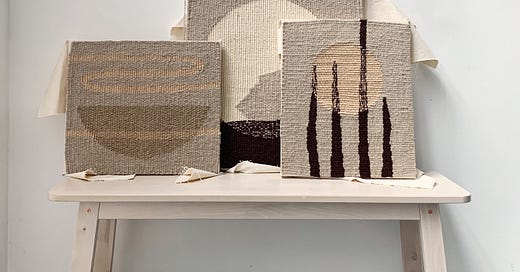This is part 2 of my “How To Stop Working For Free” series. It’s a motivational series that I’m writing mostly for myself, to work through some of the mental roadblocks and unconscious assumptions about my work, my time, and my income. Below is a free preview for all subscribers. Paid subscribers can read the whole thing.
In the autumn of 2021 I decided to take a proper stab at actually selling my art. I’d spent most of the last 12 months launching Balfour & Co, along with two new online courses, and I was ready to get back to what I saw as my real work.
The demands of my new side-hustle had left me with precious little time to actually weave anything new. But as luck would have it, I was sitting on around 4 years worth of finished tapestries, folded up in drawers, rolled up on shelves, and pinned up around my studio. I spent most of October and November stitching each one onto a canvas backing, stretching this canvas over an inner frame and fitting it with oak around the edge.
I shared regular updates on social media throughout, encouraging my instagram followers to sign up to my newsletter to be notified when my framed tapestries finally went on sale. And I spent hours pouring over spreadsheets, trying to work out the right pricing for each one. For the first time in probably my whole career, I really wanted to make sure I set a price for my work that covered my time and costs, and actually made a profit. This meant raising prices almost 30% on what I’d previously charged, but I felt confident that my work was worth it.
I launched this collection with much fanfare at the beginning of December 2021. I had dozens of requests for the price lists, thousands of likes on Instagram…
… and not a single sale.
To say I was crushed was an understatement. But more alarmingly, because I’d spent the best part of two months working on this collection at the expense of other parts of my business, I was now financially in a very tight spot. I’d even taken out a high-interest emergency loan to cover the time when I’d been working on these tapestries, feeling sure that once the collection launched I’d be able to pay it back.
I somehow managed to claw my way back into a better financial position in early 2022, but I was scarred by the whole experience. For the next two years, I focused primarily on Balfour & Co. I spent 2022 developing online courses and downsizing from my massive studio, leaving my looms to gather dust in the background.
What I think this story illustrates for all of us as creatives is that charging more has a hidden cost. So often we find ourselves stuck in the situation of not pricing our work appropriately because it’s better to get some money rather than nothing. And before you know it, you’ve built an audience that expects your work to be a certain price, and you’re stuck on the hamster wheel of never quite charging enough.
When I first started drafting the “How To Stop Working For Free” series, I realised I had to confront my own hang-ups around pricing my art. Looking back at what happened in 2021, I could clearly see the mistakes I made. I launched at a bad time (no one is buying expensive artwork for themselves that close to Christmas!), I didn’t lay the proper groundwork and I advertised to the wrong audience.
As I took the time to process and reflect on this experience, I realised that it didn’t have to be this way. There was a way for me to charge the right price for my work, and to reach the right audience. But it would require rethinking how I ran my business, and learning the lesson from my past mistakes.




